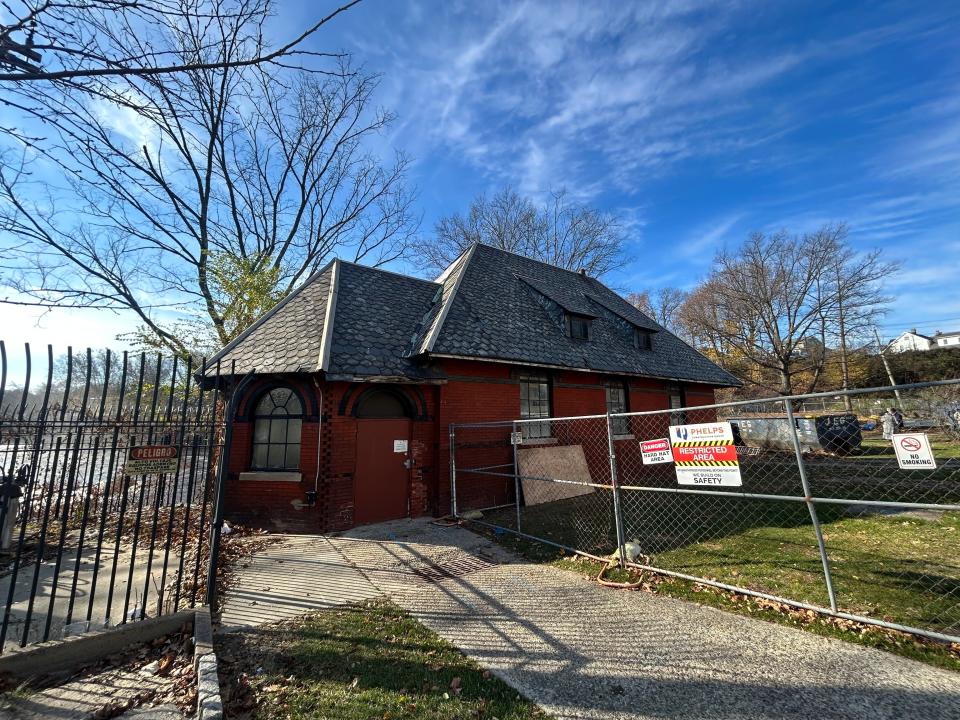This Great Falls Historical Park building in Paterson will see a $2.1M rehabilitation
PATERSON — In a city known for its towering cathedral, red brick factories and handsome government buildings, the dilapidated little pump house that sits beside Paterson’s Great Falls can easily be overlooked.
But Gianfranco Archimede, the municipal director of historic preservation, thinks the pump house is among Paterson’s most important places, a key part of a larger system that supplied a growing industrial city with fresh water in its earliest days.
“This is the story of Paterson’s first water supply,” Archimede said. “It’s one of the most exciting sites associated with the falls and I don’t think enough people know about it.”
$2.1M rehab planned
That pump house and the nearby gate house — both of which sit just above the Great Falls on the north side of the Passaic River — will be getting a $2.1 million rehabilitation, officials announced on Thursday.
The project is being handled by the Passaic Valley Water Commission, which owns the structures. The work will include new roofs, cleaning and restoring the windows and doors and restoration of the brick work that encases the buildings, officials said.
“This place was really known for the storage and movement of water,” said Darren Boch, Great Falls National Historical Park superintendent, standing near the pump house. “I appreciate the history water has played — and still plays to this day — in and around the Great Falls.”
The pump house is still functional, helping to supply 20 million gallons of water per day to homes in Paterson, Clifton and Passaic.
Officials said they were unsure how the gate house will be used once renovations are completed next August.

What is clear is that these renovations will finally rid Mary Ellen Kramer Park of its lingering blight and make it worthy of its distinction as a national park. It comes on the heels of the reopening of Hinchliffe Stadium, across the street, in May.
“This will make their stroll through the park more enticing,” Paterson Mayor Andre Sayegh said of the pump house renovation during a recent event at the Great Falls park.
As Sayegh spoke, a morning fog was hovering over the 77-foot falls, frosting the hillside with dew. In the valley below, a construction crew was working on the river walk, a $7.9 million job that will also be completed next year. The two-term mayor is presiding over the city during what might be described as the park’s most ambitious era.
The work on the pump house also has a practical side. It is part of a series of system-wide upgrades to one of the oldest water commissions in the nation, work that could run up a tab of $800 million or more over the next 10 years, according to James Mueller, executive director of the commission.
Other upgrades that the water company is making include installing emergency generators costing $29 million at its treatment plant in Totowa, updating aging mains, and replacing the open-air Levine Reservoir with $30 million storage basins to comply with new regulations. Mueller estimates that 60% of pipes will be a century old or more by the decade’s end.
“Like many of our assets, these buildings are over 100 years old, and they were in need of significant repairs,” Mueller said.
More from Paterson Press: Great Falls park will expand into 19th-century factory ruins
Russell Fries remembered
The only person missing from Thursday’s announcement was Russell Fries, the late Paterson-born historian who authored the National Register application in 1974 — and helped many understand the park’s importance in the nation’s history as the “first major hydraulic power development in the U.S.” The harnessing of the water represented “the gradual perfection of American engineering,” Fries wrote.
Archimede worked with Fries before he died last year, while the historic preservation commission was reviewing the plans for the pump house restoration. The commission approved the plan last February, Archimede said.
The Passaic Valley Water Commission was formed in 1850 and soon built its first pumping station, since demolished. The current pump house was built at the turn of the last century on top of a cliff because it utilized a free form of energy — gravity — to circulate the water.
“It was the perfect set-up where they had the waterfall, the pumping station and the pipes underground that led to three reservoirs,” Archimede said.
In addition to the growing city’s household need for potable water, the city also needed water for extinguishing fires at the mills and factories that were prone to blazes, the most devastating one coming in 1902.
“Paterson’s fire department was established pretty early because fighting fires was so important to protecting the large amount of investments being made in the city for industry,” Archimede said.
Darren Tobia is a contributing writer for Paterson Press.
This article originally appeared on NorthJersey.com: Paterson NJ: Great Falls pumphouse will see $2.1M renovation

